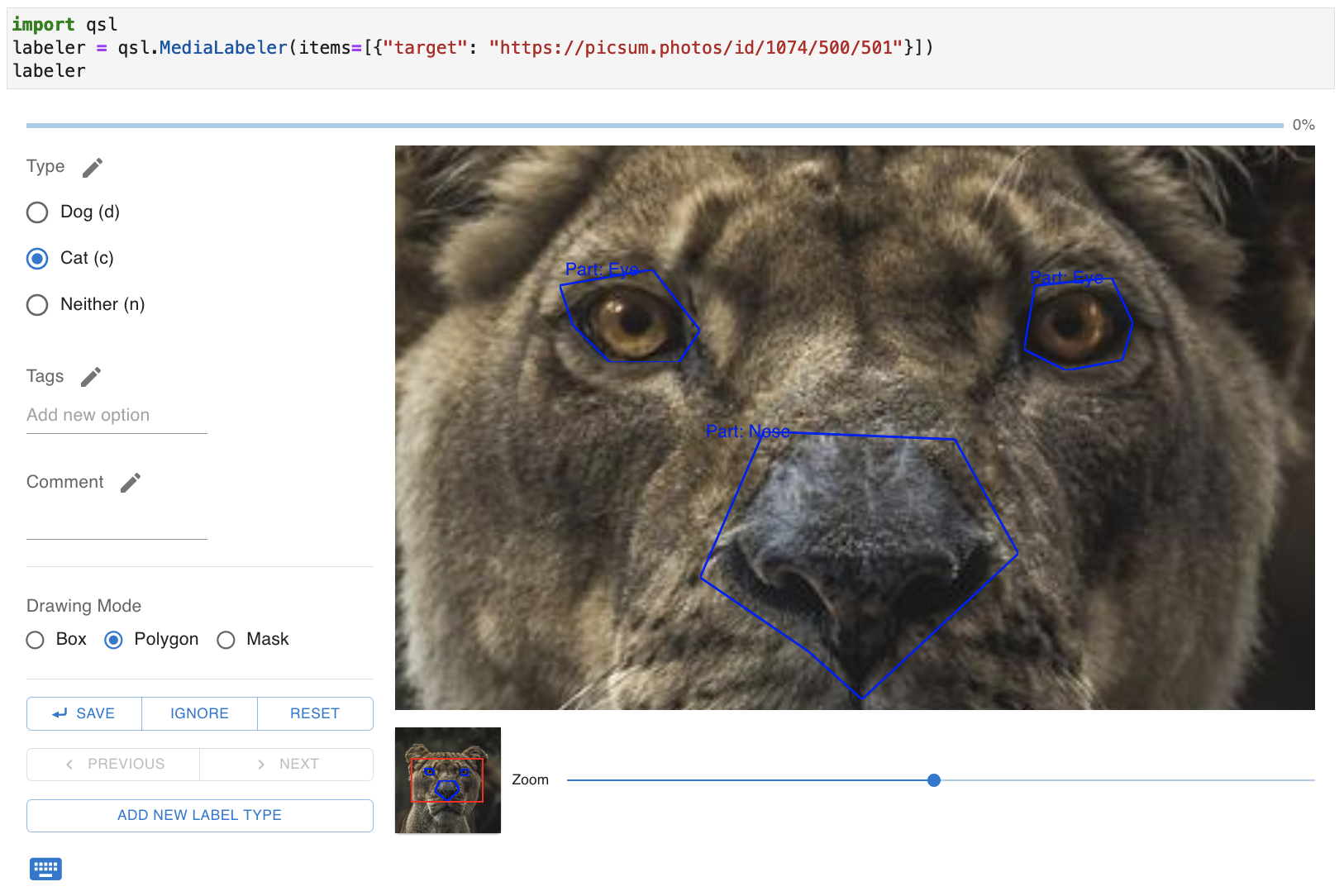Widgets for the QSL image labeling package.
Project description
QSL: Quick and Simple Labeler
QSL is a simple, open-source image labeling tool. It supports:
- Bounding box and polygon labeling.
- Configurable keyboard shortcuts for labels.
- Loading images stored locally, on the web, or in cloud storage (currently only AWS S3).
- Pre-loading images in a queue to speed up labeling.
- Deployment as shared service with support for OAuth (currently only GitHub and Google)
Please note that that QSL is still under development and there are likely to be major bugs, breaking changes, etc. Bug reports and contributions are welcome!
Getting Started
Install qsl using pip install qsl. You cannot install qsl directly from the GitHub repository because the frontend assets must be built manually.
If you are using Jupyter Notebook 5.2 or earlier and wish to use the notebook widget, you may also need to enable the nbextension:
jupyter nbextension enable --py [--sys-prefix|--user|--system] qsl
You can start a simple project labeling files from your machine using a command like the following.
qsl simple-label path/to/files/*.jpg my-qsl-project.json
Note that if my-qsl-project.json already exists and has files in it, these files will be added (the old files will still be in the project). If it does not exist, an empty project file will be created.
You can navigate to the the QSL labeling interface in a browser at http://localhost:5000 (use the --host and --port flags to modify this). From the interface, click the link to Configure project to set which labels you want to apply to images. Labels can be applied at the image or box level. There are three kinds of labels you can use:
- Single: You select 0 or 1 entry from a list of options.
- Multiple: You select 0 or more entries from a list of options.
- Text: A free-form text field.
After configuring the project, you can immediately start labeling single images from the main project page. When you're done (or just want to pause) hit Ctrl+C at the prompt where you started QSL. The labels will be available in my-qsl-project.json. You can parse this yourself pretty easily, but you can also save yourself the trouble by using the data structures within QSL. For example, the following will load the image- and box-level labels for a project into a pandas dataframe.
import pandas as pd
import qsl.types.web as qtw
with open("my-qsl-project.json", "r") as f:
project = qtw.Project.parse_raw(f.read())
image_level_labels = pd.DataFrame(project.image_level_labels())
box_level_labels = pd.DataFrame(project.box_level_labels())
Labeling Remotely Hosted Files
Note that QSL also supports labeling files hosted remotely in cloud storage (only AWS S3 is supported right now) or at a public URL. So, for example, if you want to label some files in an S3 bucket and on a web site, you can use the following command:
qsl simple-label 's3://my-bucket/images/*.jpg' 's3://my-bucket/other/*.jpg' 'http://my-site/image.jpg' my-qsl-project.json
Please note that paths like this must meet some criteria.
- On most platforms / shells, you must use quotes (as shown in the example).
- Your AWS credentials must be available in a form compatible with the default
boto3credential-finding methods and those credentials must be permitted to use theListBucketandGetObjectactions.
Advanced Use Cases
Documentation for the more advanced use cases is not yet available though they are implemented in the package. Advanced use cases include things like:
- Hosting a central QSL server with multiple users and projects
- Authentication with Google or GitHub OAuth providers
- Batched labeling for images with shared default labels
In short, you can launch a full-blown QSL deployment simply by doing the following.
- Set the following environment variables to configure the application.
DB_CONNECTION_STRING: A database connection string, used to host the application data. If not provided, a SQLite database will be used in the current working directory calledqsl-labeling.db.OAUTH_INITIAL_USER: The initial user that will be an administrator for the QSL instance.OAUTH_PROVIDER: The OAuth provider to use (currentlygithubandgoogleare supported)OAUTH_CLIENT_SECRET: The OAuth client secret.OAUTH_CLIENT_ID: The OAuth client ID.
- Execute
qsl label(instead ofqsl simple-label) to launch the application (use--hostand--portto modify how the application listens for connections).
Development
Create a dev environment using make init. Run widget development with live re-building using make develop-widget. Run app development using make develop-app. Changes to JavaScript/TypeScript require refreshing the browser. Changes to Python requires reloading the kernel (or running with autoreload).
Project details
Release history Release notifications | RSS feed
Download files
Download the file for your platform. If you're not sure which to choose, learn more about installing packages.
Source Distributions
Built Distribution
File details
Details for the file qsl-0.0.34-py2.py3-none-any.whl.
File metadata
- Download URL: qsl-0.0.34-py2.py3-none-any.whl
- Upload date:
- Size: 5.1 MB
- Tags: Python 2, Python 3
- Uploaded using Trusted Publishing? No
- Uploaded via: twine/3.8.0 pkginfo/1.8.2 readme-renderer/32.0 requests/2.27.1 requests-toolbelt/0.9.1 urllib3/1.26.8 tqdm/4.63.0 importlib-metadata/4.11.2 keyring/21.8.0 rfc3986/2.0.0 colorama/0.4.4 CPython/3.8.12
File hashes
| Algorithm | Hash digest | |
|---|---|---|
| SHA256 | fa08fe36c2ea4ef06d4f3e0f9c94deda564a8373c9ab84368b42ebe894252188 |
|
| MD5 | 5bbfc6820013b945aab6a5fc4d05c0b3 |
|
| BLAKE2b-256 | f84078d26e04c940e57fcf10ff3e8281aeada083a65745e56a0b735dc4a421f1 |












